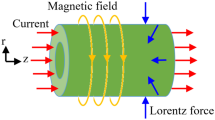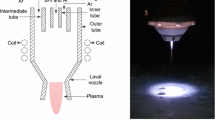Abstract
Inductively coupled atmospheric pressure plasma processing (IC-APPP) is a promising technique of generating freeform surfaces of silicon-based optics. A constant removal function related to the plasma jet morphology is important for ensuring fabrication efficiency and accuracy. However, the removal function of IC-APPP is variable due to the instability of the plasma jet morphology, thereby the need for real-time re-acquisition through multiple pre-experiments. In this study, a prediction method for the removal function of IC-APPP based on jet morphology monitoring and diagnosis is proposed to simplify the acquisition process of the removal function. According to the basic model of the Gaussian-shaped removal function, the peak removal rate (A) and the full-width at half-maximum (FWHM) are fitted as the function of the scanning velocity and jet diagnosis indexes based on the set of experimental data. A specific calculation equation can be used to rapidly predict the removal function of the current plasma jet. The revised prediction model can address dynamic changes in the plasma jet morphology by correcting the removal functions in real time. The set of processing experiments with a variable jet morphology confirms that the predicted peak removal rate (A) and FWHM are always off by less than 10% and 6% from the actual results, respectively. We believe that this prediction method is suitable for any IC-APPP process requiring a quantification of the plasma jet morphology.












Similar content being viewed by others
References
Ji P, Li D, Su X, Qiao Z, Wu K, Song L, Peng B, Wang B (2020) Optimization strategy for the velocity distribution based on tool influence function non-linearity in atmospheric pressure plasma processing. Precis Eng 65:269–278
Ji P, Jin H, Li D, Su X, Wang B (2019) Thermal analysis of inductively coupled atmospheric pressure plasma jet and its effect for optical processing. Optik 185:381–389
Dai Z, Xie X, Zhou L, Chen S, Gan Z (2019) Investigation of global thermal effect of large fused silica surface figuring using inductively coupled plasma. Optik 180:254–263
Lu Y, Xie X, Zhou L, Dai Z, Chen G (2017) Improve optics fabrication efficiency by using a radio frequency ion beam figuring tool. Appl Opt 56(2):260
Xin Q, Su X, Wang B (2016) Modeling study on the surface morphology evolution during removing the optics surface/subsurface damage using atmospheric pressure plasma processing. Appl Surf Sci 382:260–267
Su X, Ji P, Liu K, Walker D, Yu G, Li H, Li D, Wang B (2019) Combined processing chain for freeform optics based on atmospheric pressure plasma processing and bonnet polishing. Opt Express 27(13):17979
Dai Z, Chen S, Xie X, Zhou L (2019) Investigation of grinding and lapping surface damage evolution of fused silica by inductively coupled plasma etching. Int J Precis Eng Manuf 20(8):1311–1323
Li D, Li N, Su X, Ji P, Wang B (2019) Atmospheric pressure plasma processing of an optical sinusoidal grid. Micromachines 10(12):828
Dai Z, Xie X, Chen H, Zhou L (2018) Non-linear compensated dwell time for efficient fused silica surface figuring using inductively coupled plasma. Plasma Chem Plasma Process 38(2):443–459
Jourdain R, Castelli M, Shore P, Sommer P, Proscia D (2013) Reactive atom plasma (RAP) figuring machine for meter class optical surfaces. Prod Eng Res Devel 7(6):665–673
Wu J, Zhang P, Yu D, Zhang S, Xin Q, Wan Y (2020) Monitoring and diagnosis of the inductively coupled atmospheric pressure plasma jet for deterministic optical processing. Optik 214:164815
Castelli M, Jourdain R, Morantz P, Shore P (2012) Fast figuring of large optics by reactive atom plasma. SPIE Int Soc Opt Eng 8450:34
Castelli M, Jourdain R, Morantz P, Shore P (2012) Rapid optical surface figuring using reactive atom plasma. Precis Eng 36(3):467–476
Meister J, Arnold T (2011) New process simulation procedure for high-rate plasma jet machining. Plasma Chem Plasma Process 31(1):91–107
Castelli M, Jourdain R, McMeeking G, Morantz P, Shore P, Proscia D, Subrahmanyan P (2010) Initial strategies for 3d rap processing of optical surfaces based on a temperature adaptation approach. In: Processing of the 36th international MATADOR conference. Springer, pp 569–572
Su X, Zhang P, Liu K, Xia L, Li P, Zhao R, Wang B (2019) Fabrication of continuous phase plate using atmospheric pressure plasma processing. Int J Adv Manuf Technol 105(11):4559–4570
Nan Y (2016) Thermal analysis of energy beam using de-laval nozzle in plasma figuring process
Jiao C, Li S, Xie X (2009) Algorithm for ion beam figuring of low-gradient mirrors. Appl Opt 48(21):4090
Su X, Ji P, Jin Y, Li D, Qiao Z, Ding F, Yue X, Wang B (2021) Freeform surface generation by atmospheric pressure plasma processing using a time-variant influence function. Opt Express 29(8):11479
Xin Q, Wang B, Jin H, Li N, Li D, Li G (2014) Study on the key parameters in etching of fused silica using atmospheric inductively coupled plasma. Key Eng Mater 625:469–474
Jourdain R, Castelli M, Yu N, Gourma M, Shore P (2016) Estimation of the power absorbed by the surface of optical components processed by an inductively coupled plasma torch. Appl Therm Eng 108:1372–1382
Xin Q, Zhang P, Li N (2016) Research on the electron temperature and emission spectroscopy of the atmospheric inductively coupled with plasma processing. Spectrosc Spectr Anal 36(6):1872–1876 (in Chinese)
Acknowledgements
This work was supported by the China Postdoctoral Science Foundation (2020M673210), Sichuan Science and Technology Program (2020YFG0121), Fundamental Research Funds for the Central Universities (2020SCU12055), Strategic Cooperation Research Project between Sichuan University and Yibin City (2019CDYB-7), and National Natural Science Foundation of China (61905249).
Author information
Authors and Affiliations
Corresponding author
Ethics declarations
Conflict of interest
The authors declare no conflict of interest.
Additional information
Publisher's Note
Springer Nature remains neutral with regard to jurisdictional claims in published maps and institutional affiliations.
Rights and permissions
About this article
Cite this article
Tian, H., Zhang, P., Wu, J. et al. A Prediction Method of the Removal Function for Inductively Coupled Atmospheric Pressure Plasma Processing Based on Jet Morphology Monitoring and Diagnosis. Plasma Chem Plasma Process 42, 905–922 (2022). https://doi.org/10.1007/s11090-022-10247-1
Received:
Accepted:
Published:
Issue Date:
DOI: https://doi.org/10.1007/s11090-022-10247-1




